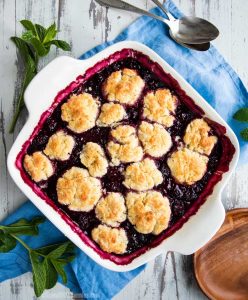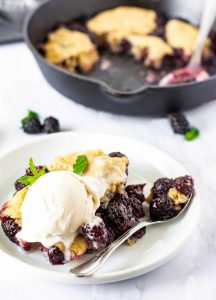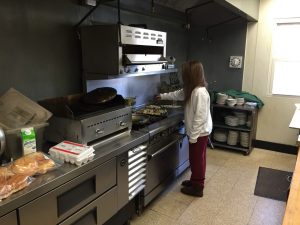As someone born and raised in Tennessee, I have never experienced a shortage of heavy calorie-laden soul food options such a biscuits, gravy, and fried chicken. Furthermore, as the descendant of a family-run, home-cooking diner, I have never experience a shortage of whatever home-made food my heart desired. One food I could not get enough of growing up combined southern comfort with diner desserts—my grandmother’s homemade cobbler. Cobbler is a deep-dish fruit dessert with the syrupy thick filling at the forefront. A successful cobbler requires a deep layer of fruit filling, a thick crust, and nothing more. The rest is up to the creator. The fruit filling can be made of any fruit really, and the crust is typically biscuit-like in nature, yet the form of the biscuit, whether it be in a sheet, uniform, or intermittent and drop-like, is again, up to the baker. Cobblers are often attributed to the deep south, as they frequently involve distinct flakey biscuits and sweet Georgia peaches. My favorite family recipe, however, is my grandmother’s cobbler, which is made using wild blackberries, and homemade drop biscuits, served warm over vanilla ice cream, and topped with whipped cream. Nothing compares to the comfort of that warm fruity dessert on the tongue during chilly winter-time holidays.
When I was growing up, not a gathering occurred without the blackberry cobbler making an appearance, and never ever did I get sick of it. We made blueberry cobbler, blackberry cobbler, raspberry cobbler, peach cobbler, apple cobbler– you name it, we made it, right there in my grandmother’s kitchen. However, for whatever reason, blackberry cobbler, won my heart, as well as the spotlight when it came to the holidays I spent in the diner’s kitchen. That process of making and baking with my grandmother around Christmas and Thanksgiving was the highlight of my childhood. Not only did I get to spend time with my grandmother having fun baking, but I got to eat the result, too! Of course, we made all kinds of other deserts down there: pies, cakes, cookies, etc. But with the discovery of my gluten intolerance, pretty early on in my teens, only the cobbler (at first, without the biscuits) made it into the “eat” phase. The sweet taste of wild blackberry cobbler, complete with warm, juicy berries fresh from the oven, became one of the things I looked forward to the most all year. Then, when I turned 16, the restaurant unfortunately closed, and the desserts and memories of my childhood halted in their tracks. My grandmother had closed up shop and moved to Florida. Luckily, the tradition had not at all stopped with my grandmother’s retirement. In her tiny tropical little kitchen, we of course, still make cobbler, just slightly modified to a smaller crowd and a new outlook on health. Now, when I visit my grandmother in Florida during the holidays, we make a new version of the legacy, but this one with gluten free biscuits (for me), dairy-free biscuits (for my grandmother), and stevia instead of sugar (for the diabetics in my family). Even with these modifications, her blackberry cobbler is just as sweet and comforting as I remember. This dish combines family tradition and southern culture, with a little less grease and sugar, making it the perfect, satisfying dessert for myself and my family.
In researching the history of my favorite dish, I found that the name “cobbler” comes from the “cobbled”-together nature of the dessert. The dish is a trail-modified version of the age-old pie concept adapted to the life of the English settlers. By nature, the dish is ready for variation, requiring limited ingredients, few resources, little skill, and nothing-near perfection. Rather cobblers are believed to have originated in the early years of European settlements, where the settlers had ideas of pie, but had to make do with what they had, which was rarely fresh fruit and neat little pie pans. Instead they had dried, canned, or syrup-preserved fruit, open fires, and biscuit makings. The dessert was often times even served as a breakfast food for the early settlers. As a southerner, this comes as little shock, since biscuits are of course, an any time staple of my geographic region. Biscuits and farm-fresh fruits combine in perfect harmony to create a dessert worthy of its own holidays: National Peach Cobbler day on April 13th, and National Cherry Cobbler Day on May 17th. For me, however, the cobbler is also more than worthy of standing front and center every day of the year, but especially during Christmas and Thanksgiving. My memories of baking and eating blackberry cobblers are irreplaceable memories, integral to my upbringing, my culture, and most of all, my family.




Grandma Irene’s Blackberry Cobbler
Biscuits:
3/4 cup gluten-free flour blend
1/4 cup oat flour
1/2 tbsp baking powder
1/4 tsp baking soda
2 1/2 tbsp refined coconut oil
1/3 cup unsweetened almond milk (or more as needed)
Filling:
4 Quarts of blackberries
1 cup powdered stevia
3 tbsp of cornstarch or coconut flour
Place blackberries in a half hotel pan and coat with stevia. Bake in the oven at 350 degrees for 45 minutes, then remove from the oven and add the cornstarch/coconut flour to a tiny bit of water until it forms a thick soupy consistency. Add this mixture to the cooked berries and stir. Then add the biscuit batter with a disher or ice cream scoop put pack into the oven to cook for another 20 minutes or when you see the biscuits turn golden brown. Serve over your favorite vanilla ice cream (we use so delicious almond milk vanilla ice cream) and whipped cream (we use reddi-whip non-dairy coconut or almond whipped cream).
Works cited:
Wulff, Alexia. “A Brief History Of Peach Cobbler.” Culture Trip, 24 Nov. 2016, theculturetrip.com/north-america/usa/articles/a-brief-history-of-peach-cobbler/.
Photo credits:
https://healthiersteps.com/recipe/vegan-blackberry-cobbler/

Hi, Courtney, it was a pleasure learning about your favorite dish, blackberry cobbler. I particularly enjoyed the history of its development. I’m glad it is still a key part of your family tradition, having withstood so many changes (dietary, business, etc.) over the years. In comparison, the research paragraph is a weaker. The resources are not explicitly cited. The information about the etymology of the name “cobbler” is interesting, but the rest of the facts paragraph seems to be piled randomly together. I believe more could be said about the “cobbled-together” nature of the dessert, perhaps in relation to your family tradition. I would also invite you to probe deeper into this family dish–other than bringing back memories, what is it about the blueberry cobbler that other staple dishes such as turkey or chicken do not offer? Is it more of a “team” dish? Any other reasons? The essay reads very smoothly in general, but there are a few places (for instance sentence#5-6 in paragraph 3) that have loose connections. Overall, well done on journal#1!